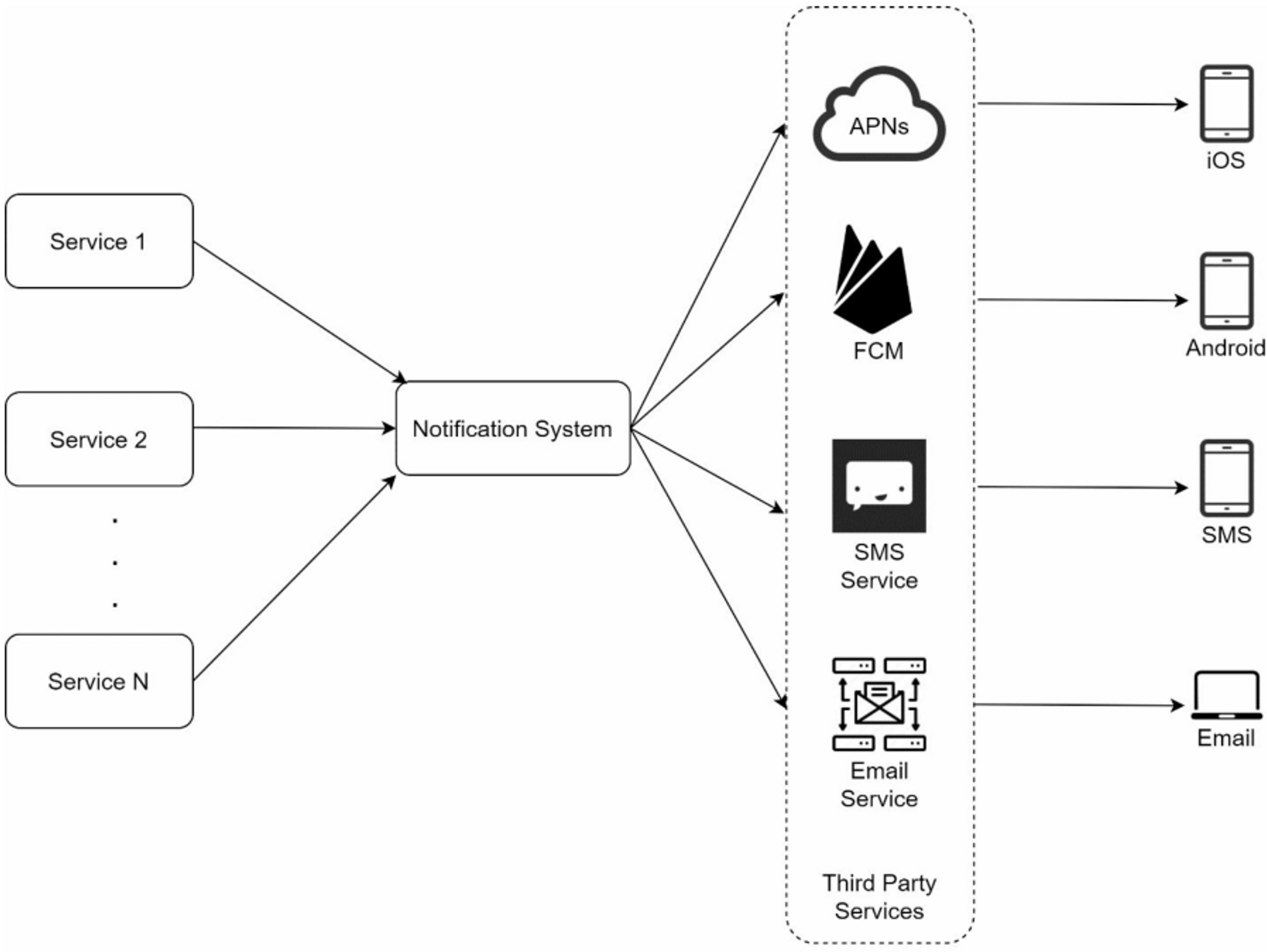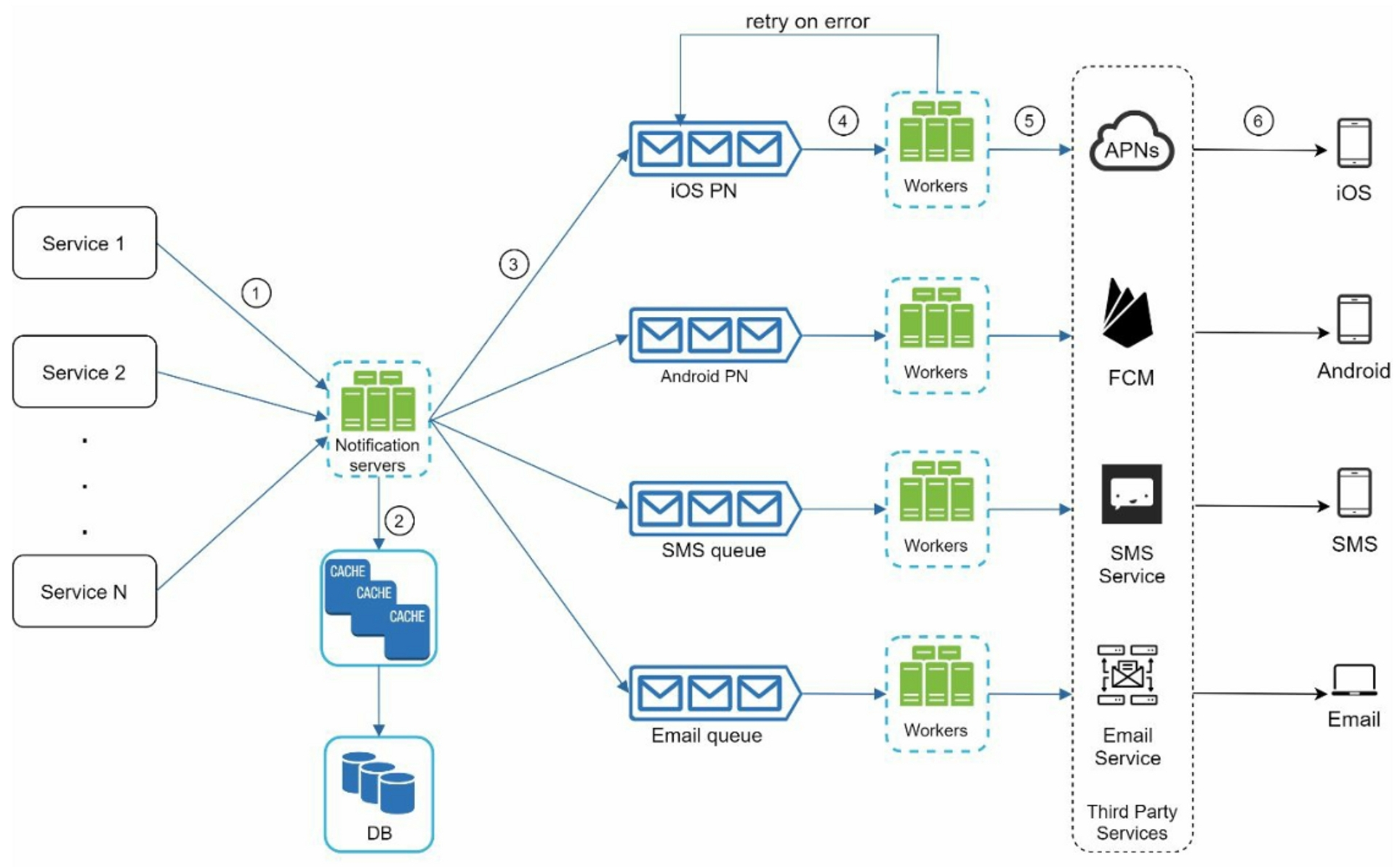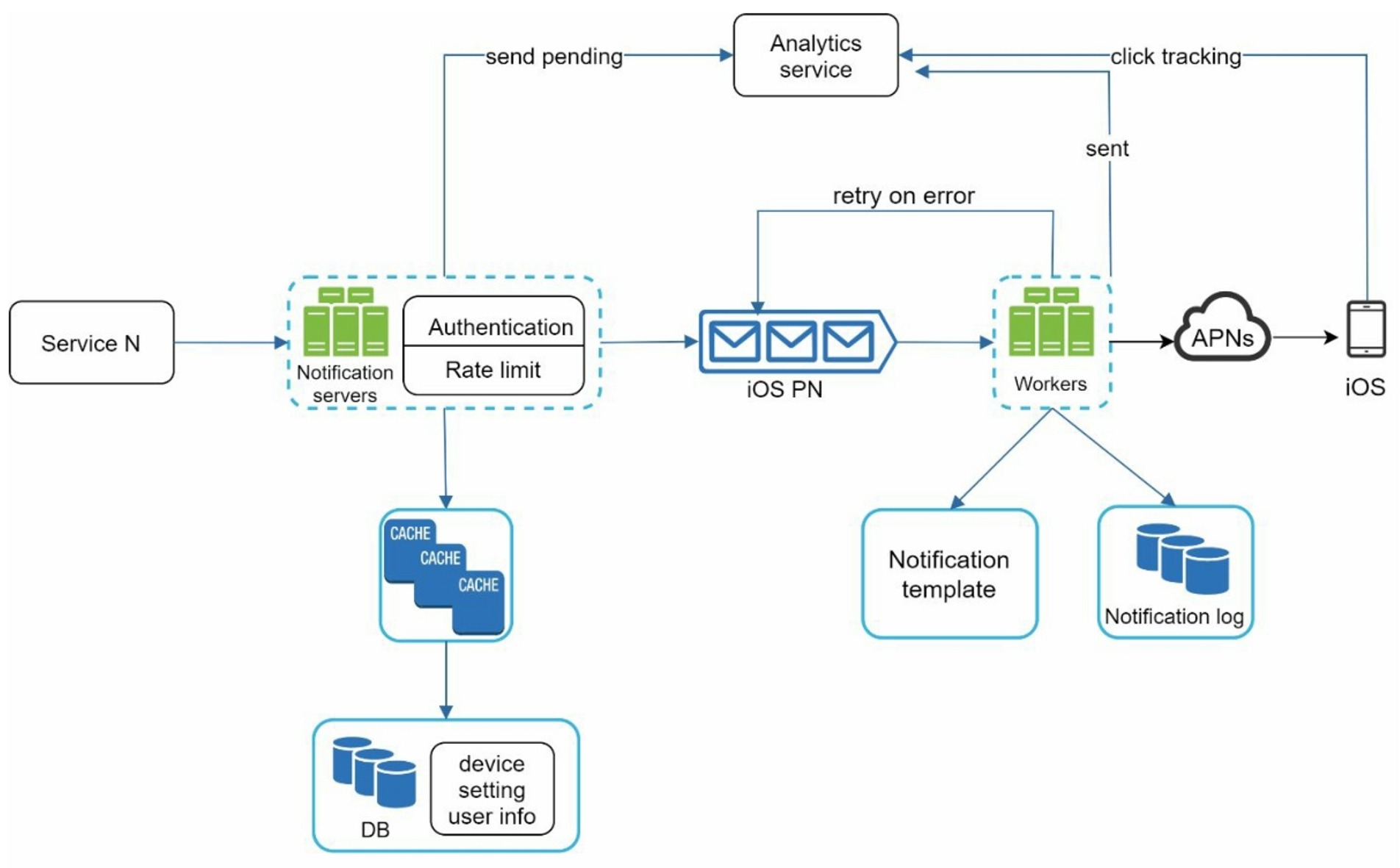System Design - Notification System
1. Introduction
A notification alerts a user with important information like breaking news, product updates, events, offerings, etc. Three types of notification formats:
- mobile push notification
- SMS message
2. Understand the problem and establish design scope
- What types of notifications does the system support: Push notification, SMS message, and email
- Is it a real-time system: a soft real-time system, if the system is under a high workload, a slight delay is acceptable
- What are the supported devices: iOS devices, android devices, and laptop/desktop
- What triggers notifications: Notifications can be triggered by client applications. They can also be scheduled on the server-side.
- Will users be able to opt-out: Yes, users who choose to opt-out will no longer receive notifications
- How many notifications are sent out each day: 10 million mobile push notifications, 1 million SMS messages, and 5 million emails.
3. Propose high-level design and get buy-in
3.1 Different types of notifications
- iOS push notification: three components to send an iOS push notification.

- Provider: build and send notification requests to Apple Push Notification Service(APNS)
- Device token: a unique identifier used for sending push notifications
- Payload: This is a JSON dictionary that contains a notification's payload
- APNS: provided by Apple to propagate push notifications to iOS devices
- iOS Device: It is the end client, which receives push notifications
- Provider: build and send notification requests to Apple Push Notification Service(APNS)
- Android push notification: Firebase Cloud Messaging(FCM) is commonly used to send push notifications to android devices

- SMS message: third party SMS services like Twilio, Nexmo, and many others are commonly used. Most of them are commercial services.

- Email: many of company opt for commercial email services which offer a better delivery rate and data analytics

3.2 Contact info gathering flow
when a user installs our app or signs up for the first time, API servers collect user contact info and store it in the database:
- Email addresses and phone numbers are stored in the
usertable - device tokens are stored in the
devicetable
3.3 Notification sending/receiving flow
3.3.1 High-level design

- Service 1 to N: A service can be a microservice, a cron job, or a distributed system that triggers notification sending events.
- Notification system: the centerpiece of sending/receiving notifications. It provides APIs for services 1 to N, and builds notification payloads for third party services.
- Third-party services: responsible for delivering notifications to users
- extensibility: system should easily plug or unplug of a third-party service
- navailablility: system should be availble for all time and regions
- iOS, Android, SMS, Email: Users receive notifications on their devices. Three problems in this design:
- Single point of failure (SPOF)
- Hard to scale: It is challenging to scale databases, caches, and different notification processing components independently.
- Performance bottleneck: Processing and sending notifications can be resource intensive. Handling everything in one system can result in the system overload, especially during peak hours.
- High-level design:
- Move the database and cache out of the notification server
- Add more notification servers and set up automatic horizontal scaling
- Introduce message queues to decouple the system components

- A service calls APIs provided by notification servers to send notifications.
- Notification servers fetch metadata such as user info, device token, and notification setting from the cache or database
- A notification event is sent to the corresponding queue for processing. For instance, an iOS push notification event is sent to the iOS PN queue.
- Workers pull notification events from message queues.
- Workers send notifications to third party services.
- Third-party services send notifications to user devices.
4. Design deep dive
4.1 Reliability
4.1.1 How to prevent data loss?
The notification system cannot lose data. Notifications can usually be delayed or re-ordered, but never lost. Thus, the notification system persists notification data in a database and implements a retry mechanism.
4.1.2 Will recipients receive a notification exactly once?
No. Although notification is delivered exactly once most of the time, the distributed system could result in duplicate notifications. Here is a simple dedupe logic: When a notification arrives, we check the event ID to see if it's seen before. If it is seen before, it is discarded; Otherwise, we will send out the notification.
4.2 Additional components and considerations
4.2.1 Notification template
Notification templates are introduced to avoid building every notification from scratch. The benefits of using notification templates include maintaining a consistent format, reducing the margin error, and saving time. A notification template is a preformatted notification to create your unique notification by customizing parameters, styling, tracking links, etc.
4.2.2 Notification setting
Before any notification is sent to a user, we first check if a user is opted-in to receive this type of notification. This information is stored in the notification setting table, with the following fields:
user_id bigInt |
4.2.3 Rate limiting
To avoid overwhelming users with too many notifications, we can limit the number of notifications a user can receive. Receivers could turn off notifications completely if we send too often.
4.2.4 Retry mechanism
When a third-party service fails to send a notification, the notification will be added to the message queue for retrying. If the problem persists, an alert will be sent out to developers.
4.2.5 Security in push notifications
Only authenticated or verified clients are allowed to send push notifications using our APIs.
4.2.6 Monitor queued notifications
A key metric to monitor is the total number of queued notifications. If the number is large, the notification events are not processed fast enough by workers.
4.2.7 Events tracking
Notification metrics, such as open rate, click rate, and engagement are important in understanding customer behaviors. Analytics service implements events tracking. Integration between the notification system and the analytics service is usually required.![]()
4.2.8 Updated design

Many new components are added in comparison with the previous design:
- The notification servers are equipped with two new features: authentication and rate-limiting.
- Add a retry mechanism to handle notification failures. If the system fails to send notifications, they are put back in the messaging queue and the workers will retry for a predefined number of times.
- Notification templates provide a consistent and efficient notification creation process
- Monitoring and tracking systems are added for system health checks and future improvements
5. Wrap up
- Reliability: a robust retry mechanism to minimize the failure rate
- Security: AppKey/appSecret pair is used to ensure only verified clients can send notifications
- Tracking and monitoring: These are implemented in any stage of a notification flow to capture important stats
- Respect user settings: Users may opt-out of receiving notifications
- Rate limiting: set up a frequency capping on the number of notifications